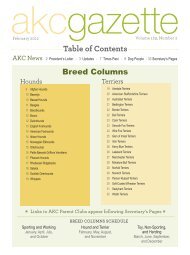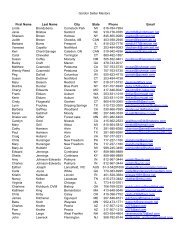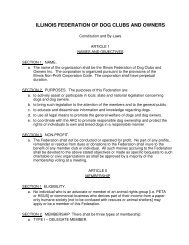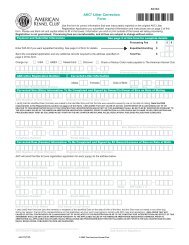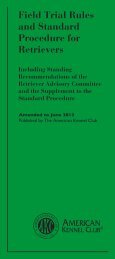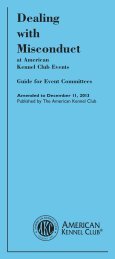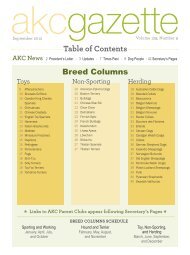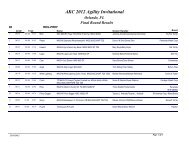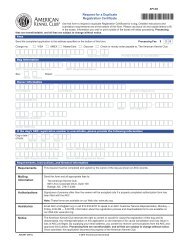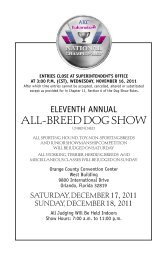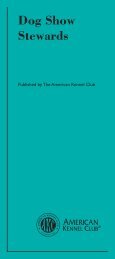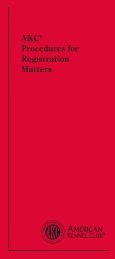Obedience Regulations - American Kennel Club
Obedience Regulations - American Kennel Club
Obedience Regulations - American Kennel Club
Create successful ePaper yourself
Turn your PDF publications into a flip-book with our unique Google optimized e-Paper software.
Rally<br />
<strong>Regulations</strong><br />
handle the dog in this class. A person may enter more than one dog in<br />
this class. no dog may be entered in both rally Advanced A and rally<br />
Advanced b at any one trial.<br />
Section 2A. Jumps. one jump must be used for this class. it may be<br />
any jump used as standard equipment in AKc obedience classes (broad<br />
jump, high jump or bar jump), except 4 foot wide jumps may be used<br />
in place of 5 foot wide jumps. A 4-inch high jump board and bar jump<br />
will be supplied for dogs that have a height at the withers of less than 10<br />
inches. this jump will be constructed so the maximum height does not<br />
exceed 4 inches, with a half-inch tolerance. this can be a separate board<br />
or support system placed between the two standard uprights. the bar or<br />
high jump board used to create this 4-inch jump height can be supported<br />
by a means other than the two standard uprights. Designs should be such<br />
that they do not interfere with the jumping of a dog. Various colors and<br />
decorations are allowed; however, there must be nothing hanging from<br />
the jump. it is the judge’s responsibility to see that the jumps are set for<br />
each dog in accordance with these regulations.<br />
the broad jump will consist of three telescoping hurdles, each<br />
approximately 8 inches wide. the largest board will measure about 4<br />
feet 10 inches long (if from a 5 foot set) and about 5 inches at the highest<br />
point. in the ring, broad jump boards will be arranged in order of size<br />
from smallest to largest. they will be evenly spaced, covering a distance<br />
equal to twice the height of the high jump set for each dog. three boards<br />
will be used for a jump of 32 inches, two boards for a jump of 16 or 24<br />
inches, and one board will be used for a jump of 8 inches. When decreasing<br />
the number of hurdles in the jump, the highest will be removed first.<br />
the high jump will consist of two uprights and solid boards of varying<br />
widths that combine to make each dog’s required jump height.<br />
the bar jump also has two uprights. these are constructed to support<br />
only a striped bar, which is set at the dog’s required jump height. the<br />
bar jump may be used in the same way as the high jump. However, if the<br />
bar jump is to be used as a jump in both directions, the uprights must be<br />
offset to allow the bar to be knocked off from either direction.<br />
Send to Jump. (Sign #210) the sign for this station will be placed at<br />
least 10 feet before the jump. the sign for this station and the one after it<br />
will be set so that the handler maintains at least a 3 foot path away from<br />
the jump while the dog performs the jump and returns to the handler.<br />
the set up and performance of this sign should not be confused with<br />
sign #103 *Send Over Jump-Handler Passes By.<br />
Note: After sending the dog to the jump the handler may pause as<br />
needed, but must not pass the jump until the dog has returned to the<br />
heel position.<br />
Section 2B. Jump Heights. the dog’s jump height shall be given on<br />
134




